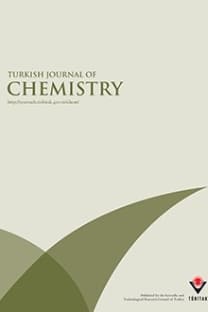Microwave-Assisted Synthesis of Some Metal-Free Phthalocyanine Derivatives and a Comparison with Conventional Methods of their Synthesis
Synthesis of metal-free 2,9(10),16(17),23(24)-tetra(3,5- dimethylphenoxy) phthalocyanine, 2,9(10),16(17), 23(24)-tetra(4- tert-butylphenoxy) phthalocyanine, and 2,9(10),16(17),23(24)-tetra(3,5- di-tert-butyl-4-hydroxyphenyl) phthalocyanine was carried out via microwave irradiation. Furthermore, pentanol and lithium were used for the first time in the synthesis of metal-free phthalocyanine under microwave irradiation as a solvent and a base-catalyst, respectively. The microwave irradiation experiments were performed in a MARS5 with a CEM XP-1500 vessel. In addition, these compounds were obtained with conventional heating procedures to compare them with those obtained with microwave irradiation. The compounds were characterized by elemental and spectroscopic analysis, including UV-Vis, H NMR, FT-IR, and MALDI-TOF mass data. In particular, both methods were compared in terms of reaction parameters and product yields. In addition, we first performed the synthesis of phthalonitriles as an initial material at room temperature, which is a slight modification of that reported in the literature. These Pc-compounds had high thermal stability, which was determined at 520 °C (midpoint), 549 °C, and 400 °C, respectively, as a maximum weight loss temperature. Consequently, the microwave irradiation method provided nearly the same or higher product yields in a very short period of time. These results suggest that the microwave irradiation method was more useful than the conventional method due to shorter reaction time and energy savings.
Microwave-Assisted Synthesis of Some Metal-Free Phthalocyanine Derivatives and a Comparison with Conventional Methods of their Synthesis
Synthesis of metal-free 2,9(10),16(17),23(24)-tetra(3,5- dimethylphenoxy) phthalocyanine, 2,9(10),16(17), 23(24)-tetra(4- tert-butylphenoxy) phthalocyanine, and 2,9(10),16(17),23(24)-tetra(3,5- di-tert-butyl-4-hydroxyphenyl) phthalocyanine was carried out via microwave irradiation. Furthermore, pentanol and lithium were used for the first time in the synthesis of metal-free phthalocyanine under microwave irradiation as a solvent and a base-catalyst, respectively. The microwave irradiation experiments were performed in a MARS5 with a CEM XP-1500 vessel. In addition, these compounds were obtained with conventional heating procedures to compare them with those obtained with microwave irradiation. The compounds were characterized by elemental and spectroscopic analysis, including UV-Vis, H NMR, FT-IR, and MALDI-TOF mass data. In particular, both methods were compared in terms of reaction parameters and product yields. In addition, we first performed the synthesis of phthalonitriles as an initial material at room temperature, which is a slight modification of that reported in the literature. These Pc-compounds had high thermal stability, which was determined at 520 °C (midpoint), 549 °C, and 400 °C, respectively, as a maximum weight loss temperature. Consequently, the microwave irradiation method provided nearly the same or higher product yields in a very short period of time. These results suggest that the microwave irradiation method was more useful than the conventional method due to shorter reaction time and energy savings.
